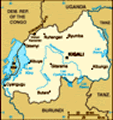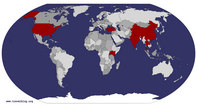Advertisement
Published: August 15th 2009
On Friday afternoon I walked to Camp Kigali, the military school and barracks where 10 Belgian UN Peacekeepers were killed at the beginning of the genocide. Part of the base is now a memorial with 10 pillars arranged in a circle, one of each of the soldiers killed. Each pillar has notches in it representing the age of the soldier killed which ranged from 25-32. The school room where they took shelter and defended themselves for a few hours is still standing and marked with bullet and grenade damage. Inside the room where they ultimately died is a plaque with each of their names and a photo. People come and leave flowers in their memory.
Brief history lesson:
On April 6, 1994, the airplane carrying Rwandan President Juvénal Habyarimana, and Cyprien Ntaryamira, the Hutu president of Burundi, was shot down as it prepared to land in Kigali. Both presidents died when the plane crashed. Responsibility for the attack is disputed, with both the RPF and Hutu extremists being blamed. But in spite of disagreements about the identities of its perpetrators, the attack on the plane is to many observers the catalyst for the genocide.
On April 6 and

 Memorial to the Fallen Belgian Peacekeepers
Memorial to the Fallen Belgian Peacekeepers
This is the room where the Belgian UN Peacekeepers died. The corner of the room is where two gernades exploded at which point the soldiers could no longer defend themselves.April 7 the staff of the Rwandan Armed Forces (RAF) and Colonel Theoneste Bagosora clashed verbally with the UNAMIR Force Commander Lieutenant General Dallaire, who stressed the legal authority of the Prime Minister, Agathe Uwilingiyimana, to take control of the situation as outlined in the Arusha Accords. Bagosora disputed the authority, and Dallaire gave an escort of UNAMIR personnel to Mrs. Uwilingiyimana to protect her and to allow her to send a calming message on the radio the next morning. But by then, the presidential guard had occupied the radio station and Mrs. Uwilingiyimana had to cancel her speech. In the middle of the day, she was assassinated by the presidential guard. The ten Belgian UNAMIR soldiers sent to protect her were later found killed; Major Bernard Ntuyahaga was convicted of the murders in 2007.
After that, I walked to the home of Dr. Kandt, a German who came to Rwanda in 1898 seeking the source of the Nile. He found it and his discovery was unchallenged until 2006 when a longer route was discovered. He later served as the only German President of Rwanda during German colonization. He is credited with bringing coffee to Rwanda, now a major
cash crop and one of the main exports. His home sites on a hill on the edge of town with a very nice view of the surrounding townships. The home has become the Museum of Natural History and I had a private tour of the museum as I was the only guest. They have a piece of a moon rock there along with a Rwandan flag that the US carried into outer space, a gift to the people of Rwanda from Richard Nixon in 1973.
It was a lot of walking up and down hills and I decided I was hungry. I went to Karibu and ordered a pizza which took an hour to arrive! Luckily, I ordered a big beer since it was Friday and it was a nice night out, so I just waited and enjoyed relaxing after a busy week.
On Saturday morning, Emmanuel picked me up right at 8:00am and I set out for a day of sight seeing. I first went to Nyanza which is about two hours from Kigali. In 1898, Mwami (King) Musinga Yuhi V decided to break with royal tradition and establish one residence from which he would rule. His

 View from Dr. Kandt's Terrace
View from Dr. Kandt's Terrace
View of a banana plant, the Kigali Prison, a school, and the Kigali townshipspredecessors typically had 50-60 residences in the country, but the Mwami was feeling threatened by the growing colonial presence in his country and decided one residence would help consolidate his dwindling power. He selected Nyanza Hill as the site of the first permanent capital where it remained throughout his reign and that of his son who built two large houses on the site. The house of Musinga has been reconstructed and is made entirely of thatch. You can go inside it and even sit on his throne! It’s a well designed house with a gigantic bed! He had six wives, but one main Queen who lived with him while his other wives received occasional visits. Behind the palace are a milk hut and a beer hut, both of which you can go inside and are also nice. The king’s milk and beer had to be closely guarded against poison and he had other people taste everything before he would drink.
The son’s first house is nice, but I preferred the thatch hut! The second house is even grander and sites on a hill a few km away and I did not visit this.
We next went to the
National Museum of Rwanda, opened in 1988 and presented to the people of Rwanda as a gift from Belgium’s King Baudouin I. It’s a well designed museum and the seven rooms the country and its people from earliest time until present day. The genocide is mentioned on briefly in the description of Presidents Habyarimana and his successor, President XXX.
I wanted to see the Genocide Memorial in Butare and was first told it was closed, but I asked to drive by it anyway. We found it and it’s actually very small which surprised me as Butare suffered greatly during the genocide.
Butare was for many years the intellectual and cultural center of Rwanda and Tutsi and Hutus had lived and studied peacefully there. And initially, it seemed that Butare could resist the madness of the genocide. When the killing started, people flocked to Butare from the countryside believing they would find safety. The prefect of Butare, Jean-Baptiste Habyarimana (no relation to the President), was the only Tutsi prefect in Rwanda at the time of the genocide. He took charge, welcoming refugees, reassuring parishioners, and demonstrating such authority that for two weeks while the killing raged elsewhere, relative calm

 Me on the King
Me on the King
This one is for Dr. Smith's bulletin boardprevailed in Butare with only isolated incidences of violence.
Sadly, it couldn’t last and, because of his defiance, the prefect was fired from his post and murdered. His successors were a hard line military officer and an equally militant civil administrator. Under their orchestration, paramilitary units were airlifted in from Kigali and the killing started immediately. Ultimately, the massacres around Butare were some of the worst of the genocide and the death total of 220,000 is the highest of any prefecture.
I next visited two genocide memorials near Kigali, both of which were Catholic churches where people sought refuge.
We went to Ntarama Church, a small church where approximately 5,000 people were slaughtered. The sanctuary contains church pews with the clothing of the massacred hanging from the walls. In the back of the church are large racks with rows of skulls and bones. Also on display are the personal objects of the people and some machetes and knives used in the killings. In the Sunday School building there is a large blood stain on the wall where young children and babies were thrown against the wall and killed. The kitchen building was partially destroyed and what remains

 The King's Giant Bed
The King's Giant Bed
The bed covering is bark cloth which is surprisingly soft. Milk jugs and baskets for storing persnal items are along the back and sides of the bed.is littered with clothing and burnt mattresses as many people were burned alive here.
I’m torn in places like this about taking pictures. It seems macabre, but it’s also important to document what happened to show people who can’t see it for themselves. Photos were not encouraged here, but the woman did say I could take a few.
We next went to Nyamata Church and had a tour by a young man who survived the slaughter in the sanctuary. His older brother his him in a pile of bodies near a wall and told him not to move until he came back for him. His brother did not survive, but the eight year old did. He still lives in the town and now gives talks to visitors. This is a larger church and between 10,000 and 11,000 people were slaughtered here. The pews in the sanctuary are covered with the clothing of the people killed. The alter and baptismal font and in place, but damaged. There is obvious grenade and bullet damage and blood stains on the ceiling and a wall where children were killed. In a room constructed under the sanctuary, there is one coffin holding a

 Inside the Beer Hut
Inside the Beer Hut
The jugs are for banana beer, sorghum beer, and meadewoman and her baby on display underneath a glass case holding skulls and bones. The guide kept urging me to take photos so I could show people in the US.
Outside the church are several mass graves, including the grave of 56 people taken from the church and buried alive. When they were recovered, they were brought back to the church and placed in a common grave. Near the graves is an underground crypt containing a few dozen caskets containing the bodies of people who were identified after the genocide was over. There are several rooms with floor to ceiling shelves containing skulls and other bones. As new genocide victims are discovered, their bones are brought to the church.
Both memorials are grim and I was feeling fairly nauseas as we drove back to Kigali. The driver offered to stop at another memorial spot, but I’d had enough for the afternoon and just came back home.
The Gisozi Genocide Memorial in Kigali shows movies on some Thursdays and Saturdays preceded by a talk by a genocide survivor. I called earlier this week and they said they were showing a movie tonight. After a quick dinner of cold,

 Rwandan Scenery
Rwandan Scenery
Along the road from Butare to Kigalileftover pizza, I took a motorcycle taxi to the center. He dropped me off, but the guard at the gate said the center was closed. I asked about the movie and he said “closed” again. I said that I had called and they told me there was a movie and he said “closed” again. I asked if he was sure and he used his rifle as a point of emphasis this time so I called my motorcycle taxi back and he brought me back home. So, I spent 2000 FRW (about $3.50) on a motorcycle ride!
Tomorrow I’m going to Kibuye for the day. I bought a bus ticket this morning so I will have my first public bus experience in the morning. The ticket cost $4 and it’s only a two hour drive so I’m sure it will be fine…
Advertisement
Tot: 0.079s; Tpl: 0.021s; cc: 13; qc: 27; dbt: 0.0376s; 1; m:domysql w:travelblog (10.17.0.13); sld: 1;
; mem: 1.1mb














